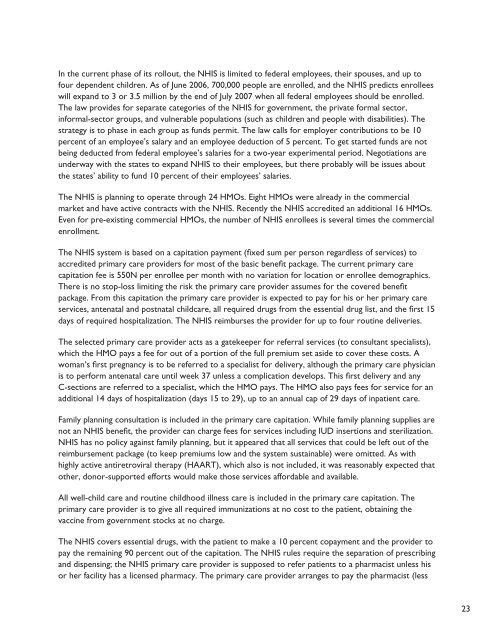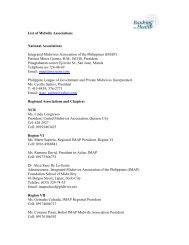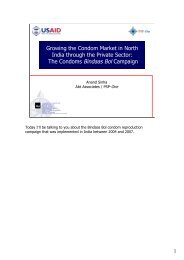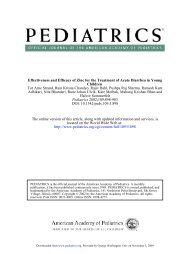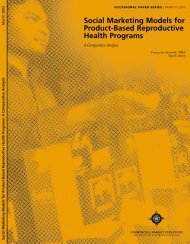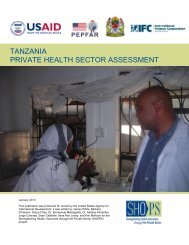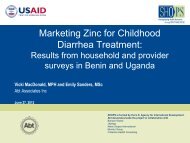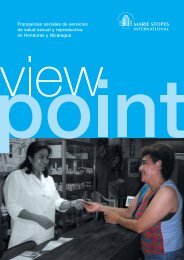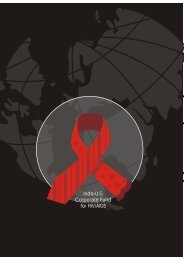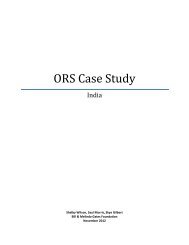Nigeria Private Sector Health Assessment - SHOPS project
Nigeria Private Sector Health Assessment - SHOPS project
Nigeria Private Sector Health Assessment - SHOPS project
Create successful ePaper yourself
Turn your PDF publications into a flip-book with our unique Google optimized e-Paper software.
In the current phase of its rollout, the NHIS is limited to federal employees, their spouses, and up to<br />
four dependent children. As of June 2006, 700,000 people are enrolled, and the NHIS predicts enrollees<br />
will expand to 3 or 3.5 million by the end of July 2007 when all federal employees should be enrolled.<br />
The law provides for separate categories of the NHIS for government, the private formal sector,<br />
informal-sector groups, and vulnerable populations (such as children and people with disabilities). The<br />
strategy is to phase in each group as funds permit. The law calls for employer contributions to be 10<br />
percent of an employee’s salary and an employee deduction of 5 percent. To get started funds are not<br />
being deducted from federal employee’s salaries for a two-year experimental period. Negotiations are<br />
underway with the states to expand NHIS to their employees, but there probably will be issues about<br />
the states’ ability to fund 10 percent of their employees’ salaries.<br />
The NHIS is planning to operate through 24 HMOs. Eight HMOs were already in the commercial<br />
market and have active contracts with the NHIS. Recently the NHIS accredited an additional 16 HMOs.<br />
Even for pre-existing commercial HMOs, the number of NHIS enrollees is several times the commercial<br />
enrollment.<br />
The NHIS system is based on a capitation payment (fixed sum per person regardless of services) to<br />
accredited primary care providers for most of the basic benefit package. The current primary care<br />
capitation fee is 550N per enrollee per month with no variation for location or enrollee demographics.<br />
There is no stop-loss limiting the risk the primary care provider assumes for the covered benefit<br />
package. From this capitation the primary care provider is expected to pay for his or her primary care<br />
services, antenatal and postnatal childcare, all required drugs from the essential drug list, and the first 15<br />
days of required hospitalization. The NHIS reimburses the provider for up to four routine deliveries.<br />
The selected primary care provider acts as a gatekeeper for referral services (to consultant specialists),<br />
which the HMO pays a fee for out of a portion of the full premium set aside to cover these costs. A<br />
woman’s first pregnancy is to be referred to a specialist for delivery, although the primary care physician<br />
is to perform antenatal care until week 37 unless a complication develops. This first delivery and any<br />
C-sections are referred to a specialist, which the HMO pays. The HMO also pays fees for service for an<br />
additional 14 days of hospitalization (days 15 to 29), up to an annual cap of 29 days of inpatient care.<br />
Family planning consultation is included in the primary care capitation. While family planning supplies are<br />
not an NHIS benefit, the provider can charge fees for services including IUD insertions and sterilization.<br />
NHIS has no policy against family planning, but it appeared that all services that could be left out of the<br />
reimbursement package (to keep premiums low and the system sustainable) were omitted. As with<br />
highly active antiretroviral therapy (HAART), which also is not included, it was reasonably expected that<br />
other, donor-supported efforts would make those services affordable and available.<br />
All well-child care and routine childhood illness care is included in the primary care capitation. The<br />
primary care provider is to give all required immunizations at no cost to the patient, obtaining the<br />
vaccine from government stocks at no charge.<br />
The NHIS covers essential drugs, with the patient to make a 10 percent copayment and the provider to<br />
pay the remaining 90 percent out of the capitation. The NHIS rules require the separation of prescribing<br />
and dispensing; the NHIS primary care provider is supposed to refer patients to a pharmacist unless his<br />
or her facility has a licensed pharmacy. The primary care provider arranges to pay the pharmacist (less<br />
23


